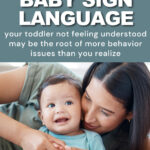The Best Baby Sign Language Apps to Help Avoid Fits & Misunderstandings
You’re in a restaurant or store when suddenly your 18-month old starts screaming and letting the world know how unhappy he is. It doesn’t happen because your child is a “bad kid”. It happens because, most likely, he can’t communicate what he needs in the moment.
Tantrums can be stressful for parents as well as “innocent bystanders.” As a result, we can find ourselves tiptoeing around our child, trying to avoid whatever triggers outbursts.

Understanding your toddler’s moods and motivations can be challenging. But few parents really grasp the link between a child’s frustration over communication and their tendency to have emotional outbursts.
Communicating with Baby Early On
“In working with many babies (and my own children), I have found their ability to learn and understand often goes far beyond their ability to communicate with words,” explains Andrea Ploehn, expert on nonverbal communication and baby sign language. “As the gap grows between what they are able to understand and what they are able to communicate, tantrums often result.”
But parents who learn to communicate with their little ones through sign language are often able to cut down on the number and severity of tantrums.
Being understood is one of the most fundamental human desires. Young children learn through patterns and repetition. When babies experience disappointment communicating over and over again, it can significantly affect their confidence. This can lead to tantrums and withdrawing from social interactions.
What Is Baby Sign Language?
“Baby signing” refers to the use of hand gestures from American Sign Language (ASL) – or British Sign Language, Japanese Sign Language, etc. – but with “motherese” modifications: that is, adjusting signing space, signing size, and sign duration or length to emphasize a salient sign and/or word. (source)
Essentially it is sign language made accessible for babies and toddlers.
How Can Baby Sign Language Help?
Andrea is a mother of four. She noticed her son Ben struggling to communicate with the rest of their family and decided to intervene with sign language. Here is her story:
He struggled to get his mouth to produce the ‘R’ sound, and he frequently omitted the ‘S’, ‘Th’, and ‘Ch’ sounds in many words. He got so frustrated when people couldn’t understand him. He would either avoid interacting or he would start screaming and throwing a tantrum.
I’ve worked with many parents of children who have dealt with similar problems. They tend to feel overwhelmed because they don’t know how to help their child.
With Ben, I decided that anytime I discovered what he was trying to say, I would teach him the sign language for that word. I was then able to help him learn how to pronounce the words he was verbally struggling to say.
For instance, Ben would say “ga” for multiple things. He’d say “ga” for water, “ga, ga” for dog, and “gaaa” for book. One day he was trying to tell me what he wanted, and I couldn’t understand him. We wandered around the house until he saw the book he wanted, and said, “gaaa, gaaa, gaaa.”
Right away I showed him the sign for book. I took his hands and had him make the sign. We did it a few times until I could tell he understood.
Later that night when I was putting him to bed he said “ga”. I asked if he wanted some water, he said no and started signing “book.” I grabbed a book and he started jumping up and down yelling, “yeah!”
What a relief and pure sense of joy and accomplishment we both felt. Ben has continued to build confidence, avoid tantrums, and excel socially. I truly feel that baby signing has enabled him to progress when he otherwise would have fallen behind and lost confidence.
The Best Baby Sign Language Apps
There’s no need to wait and see if your baby will struggle with communication. You can begin teaching your little one baby sign language from the early months.
Babies can begin to learn to sign as soon as they recognize basic cause and effect patterns and have the motor skills to form signs with their fingers.
And the good news is – you don’t have to be an expert in ASL to teach your baby. You only need to start with the most common baby signs. Here are the best apps to help your family learn ASL basics.
The free version of the app features animated video demonstrations. Use them for yourself or if you’re working with a toddler, watch them together. Practice by playing the fun interactive quiz and inspire your baby to sign with the aid of the colorful flashcards.
This baby sign language app is intended for use by toddlers, but you can also use it to teach yourself sign language for communication with an infant. The app features video footage with an experienced sign language instructor. Use the interactive lessons to learn signs for numbers, letters, family members, animals, greetings, and more.
Baby Signs is a free app with video clips. The signs are sortable alphabetically or by category. This app also offers a quiz to test your knowledge. This free version offers 22 common signs. The full version offers 230 signs you can learn at your own pace.
Signing Time ASL focuses on simple signs for baby. It features flashcards and video clips for 48 signs. The developer explained that the small number of signs is because the app is intended to provide core words that are commonly used, and not to overwhelm a young child. This great app also offers children’s song videos and the ability to track progress.
My Smart Hands Baby Sign Language Dictionary
For those that prefer an app with more signs, My Smart Hands Baby Sign Language Dictionary ($4.99) offers 300 ASL signs and instructional videos. Despite the name, this app is more than a dictionary. It offers detailed instructions for each sign, along with memory tips and a quiz to check your progress. Signs can be organized by a favorites list or by category. There’s also a search option.
Do you have another resource that should be on the list of best baby sign language apps? Let us know in the comments.
If you are concerned about your child’s verbal communication or speech development (and your instincts will tell you), speak to your health care provider or ask for speech-language pathologists recommendation for an evaluation.

